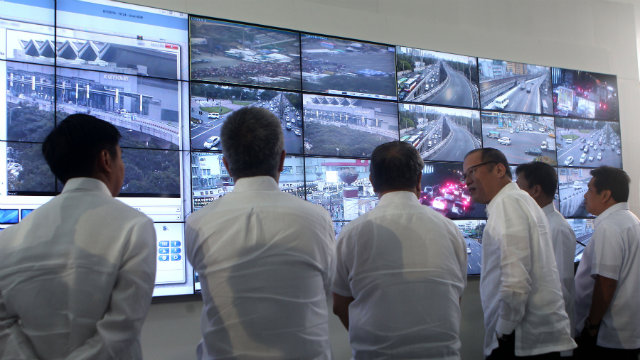SUMMARY
This is AI generated summarization, which may have errors. For context, always refer to the full article.

MANILA, Philippines – The goal is less traffic.
With the Metro becoming more and more congested, the Metropolitan Manila Development Authority (MMDA) inaugurated a state-of-the-art Traffic Signalization System (TSS) on Wednesday, January 8, that is expected to reduce traffic and travel time, and make the roads safer for pedestrians and commuters.
The advanced traffic management network will be based in MMDA’s new Command and Control Center in Makati City.
At the launch, President Benigno Aquino III said the new center “will serve as the brains for the monitoring and movements of the MMDA in its thorough observations of the traffic situation, disasters and public security.”
“Aside from its quick communications technology, it can also observe over 400 intersections in Metro Manila,” he said.
The system will initially manage 85 priority intersections and 25 video surveillance locations. Phase 1 of the project also includes the installation of 36 units of 45-inch video screens that will monitor 150 CCTVs in the metropolis. It will also increase the number of stoplights with countdown timers.
The system is expected to eventually manage up to 500 intersections across Metro Manila.
Phase 1 costs more than P295 million, while the other phases are continuously being studied and prepared with a target to finish Phase 3 by 2016 when the President steps down.
Aquino said it would also help the MMDA respond to problems on the road. (READ: Taming the traffic beast of Metro Manila)
“For example, if the CCTV camera shows that one road has traffic, and the other is free-flowing, the Command and Control Center can control the time and speed of the green and red lights on the intersection, in order to free up the road making the flow of traffic more efficient,” he said.
The President added the upgrade comes at an opportune time. The old signalized system has been in place for 14 years now, resulting in defective computers in 424 intersections, and damaged traffic lights and loop detectors.
The number of cars on the road also continues to rise. In 2013, the registered vehicles in Metro Manila reached over two million, resulting in heavy traffic. The Philippines has 7.6 million total registered vehicles – meaning close to 30% of all vehicles are in the Metro.
Aquino said the traffic also affects the economy because of the time, money and gas wasted, with the National Economic and Development Authority pegging the daily cost of traffic at P2.5 billion.
Follow the law
Because of the headaches caused by traffic, Aquino said the government continues to look for solutions to the Metro’s congestion problem.
He said in addition to his administration’s implementation of the Metro Manila Integrated Transport System, Uniform Ticketing System, Truck Ban, flood control, rerouting and road reblocking – this project is the government’s newest initiative.
“[The system] can analyze and consolidate information for faster mobility, improved road safety, optimized vehicle flow and pedestrian movement, and reduced travel times,” MMDA Chairman Francis Tolentino said.
He said the TSS “aims to upgrade, automate and optimize the management and traffic engineering installations” around the Metro.
But for now, as the project has yet to be completely rolled out, Aquino appealed to Filipinos to do their share in helping decrease traffic.
“My request to our countrymen is this: I hope we can be disciplined on the road. Even if sometimes, we are tempted partly because of irritation or boredom on the road, let us not make this a reason to break the law or cheat the system,” he said.
“This is for the good of all of us anyway. So whether you drive a car or a motorcycle or you’re just a pedestrian crossing the lane – let’s follow the rules. Let us not wait until an official or a camera catches us, or until we are punished, before we learn to follow the law and the system.”
He said as President, he himself has refrained from using his presidential privilege to clear roads when he travels and refuses to use a wang-wang or blaring sirens.
“But this does not mean that I am passing on this privilege to others. You know, nobody has the license to use a wang-wang mentality, and act like a king on the road,” he said.
On November 30, Makati Mayor Junjun Binay – son of Vice President Jejomar Binay – allegedly ordered the arrest of 3 security personnel from the posh Dasmariñas Village in Makati after his 4-car convoy was not allowed to exit through one of its gates.
The Binays were criticized for their wang-wang mentality. – Rappler.com
Add a comment
How does this make you feel?
There are no comments yet. Add your comment to start the conversation.